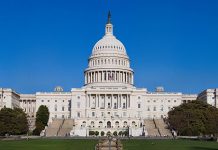In support of the Trump Administration’s Executive Order on Promoting Agriculture and Rural Prosperity in America, the U.S. Environmental Protection Agency (EPA) joined the U.S. Department of Agriculture (USDA) Forest Service and the Northern Border Regional Commission in announcing assistance to help communities revitalize their economy through outdoor recreation.
“Outdoor recreation not only plays an important role in the health and wellbeing of millions of Americans, but it also generates billions in economic activity and supports millions of jobs,â€Â said EPA Administrator Wheeler. “We look forward to working with communities and our federal partners on strategies that can grow the local recreation economy and revitalize main street while protecting our vital natural resources.â€
“By partnering alongside EPA and the Northern Border Commission, the Forest Service is proud to help communities deliver recreation experiences that better meet the needs of visitors and support local economies,â€Â said Vicki Christiansen, USDA Forest Service Chief. “We are committed to sustaining the nation’s forests and grasslands through public-private partnerships that engage people directly in the shared stewardship of their natural resources.â€
“We are excited to launch this collaborative effort to provide opportunities to establish outdoor recreation as a prominent economic sector of rural economies,â€Â said Harold B. Parker, Federal Co-Chair of NBRC.
According to the Outdoor Industry Association’s 2017 report on The National Outdoor Recreation Economy, outdoor activities – including hiking, biking, boating, fishing, hunting, birdwatching, off-road vehicle riding, skiing, snowmobiling, and viewing historic places – generated $887 billion in annual spending and created more than seven million jobs. These activities can bring new investment to local economies, heighten interest in conservation of forests and other natural resources, and improve quality of life for residents and visitors.
Through this latest federal assistance, a planning team will help communities bring together local residents and other stakeholders to decide on strategies and an action plan to grow the local outdoor recreation economy. The planning assistance process will take place over a period of four to six months, with a focal point being a two-day facilitated community workshop. Participants will work together to identify a vision, goals, and specific actions to realize the locally set goals.
Partner communities are encouraged to pursue activities that foster environmentally friendly community development and main street revitalization through the conservation and sustainable use of public or private forests or other natural resources. Examples include:
- building or expanding trail networks to expand use and attract visitors and new businesses
- developing in-town amenities, such as broadband service, quality housing, or local shops, restaurants, or breweries, to serve residents and help attract new visitors and residents with an interest in nearby outdoor assets;
- marketing main street as a gateway to nearby natural lands and recreational opportunities; and
- developing a community consensus on the management of outdoor assets.
EPA and its federal partners expect to announce in summer 2019 the selection of eight communities for planning assistance. The deadline for application is May 31, 2019.
Applications may be submitted on behalf of any U.S. community. Special consideration will be given to communities that are:
- small towns;
- economically disadvantaged, such as those in Opportunity Zones; and/or
- in the Northern Border Region.
EPA’s Smart Sectors program also provides support to grow the outdoor recreation economy. In 2018, EPA offices in the New England and Mountains and Plains regions established Smart Sectors programs that recognize the wealth of natural resources and outdoor recreational opportunities that can be leveraged to create jobs, spur new businesses, and support economic revitalization.
The USDA Forest Service develops and implements place-based recreation planning using collaborative processes with communities and outdoor recreation and tourism providers within regional destination areas. Forest Service recreation programs support over 205,000 jobs, the majority of which are in rural gateway communities near national forests. Â The agency partners with states, tribes, local communities, and landowners to promote shared stewardship of public and privately-owned forests and grasslands.
The Northern Border Regional Commission provides federal funds for critical economic and community development projects throughout the northeast.  These investments lead to new jobs being created and leverages substantial private sector investments.
For more information:Â https://www.epa.gov/smartgrowth/recreation-economy-rural-communities



